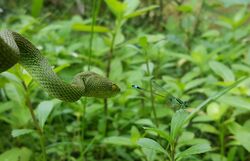Biology:Trimeresurus erythrurus
| Trimeresurus erythrurus | |
|---|---|

| |

| |
| Scientific classification | |
| Domain: | Eukaryota |
| Kingdom: | Animalia |
| Phylum: | Chordata |
| Class: | Reptilia |
| Order: | Squamata |
| Suborder: | Serpentes |
| Family: | Viperidae |
| Genus: | Trimeresurus |
| Species: | T. erythrurus
|
| Binomial name | |
| Trimeresurus erythrurus (Cantor, 1839)
| |
| Synonyms | |
| |
Trimeresurus erythrurus, commonly known as the red-tailed bamboo pitviper,[3] redtail bamboo pit viper, and redtail pit viper is a venomous pit viper species found in South Asia and Myanmar. No subspecies are currently recognized.[2]
Description
Males grow to a maximum total length 575 millimetres (22.6 in), of which the tail is 120 millimetres (4.7 in) in length. Females reach a maximum total length of 1,045 millimetres (41.1 in), with a tail length of 165 millimetres (6.5 in).[4]
Scalation: dorsal scales in 23–25 longitudinal rows at midbody; first upper labial partially or completely fused to nasal; 9–13 upper labials, 1–2 rows of scales separate upper labials from the suboculars; 11–14 scales in a line between supraoculars; supraoculars rarely divided; temporal scales small, strongly keeled; ventral scales: males 153–174, females: 151–180; subcaudals: males 62–79, females 49–61, usually paired, occasionally unpaired shields present among paired series.[4]
Color pattern: head uniform green, dorsum bright green, light ventrolateral stripe present in males, present or absent in females (Maslin [1942:23] says that the ventrolateral stripe is absent, but M.A. Smith [1943:523] states that it is present in males and variable in females), tail spotted with brown; hemipenes without spines.[4]
Geographic range
Found in eastern India (Assam, Sikkim, Manipur), Bangladesh, Myanmar, Bhutan, and Nepal.[2] The original type locality given was as "Delta Gangeticum" (Ganges Delta, West Bengal State, eastern India). The type locality given by Boulenger (1896) is "Ganges Delta."[1]
References
- ↑ 1.0 1.1 McDiarmid RW, Campbell JA, Touré T. 1999. Snake Species of the World: A Taxonomic and Geographic Reference, Volume 1. Herpetologists' League. 511 pp. ISBN:1-893777-00-6 (series). ISBN:1-893777-01-4 (volume).
- ↑ 2.0 2.1 2.2 Trimeresurus erythrurus at the Reptarium.cz Reptile Database. Accessed 16 November 2020.
- ↑ Gumprecht A, Tillack F, Orlov NL, Captain A, Ryabov S. 2004. Asian Pitvipers. GeitjeBooks. Berlin. 1st Edition. 368 pp. ISBN:3-937975-00-4.
- ↑ 4.0 4.1 4.2 Leviton, A.E.; Wogan, G.O.U.; Koo, M.S.; Zug, G.R.; Lucas, R.S.; Vindum, J.V. (2003). "The dangerously venomous snakes of Myanmar. Illustrated checklist with keys". Proceedings of the California Academy of Sciences 54 (24): 407–462. http://researcharchive.calacademy.org/research/scipubs/pdfs/v54/proccas_v54_n24.pdf.
Further reading
- Cantor, T.E. 1839. Spicilegium serpentium indicorum [parts 1 and 2]. Proc. Zool. Soc. London, 7: 31–34, 49–55.
- Cantor, T.E. 1840. Spicilegium Serpentium Indicorum. Ann. Mag. Nat. Hist. (1) 4: 271–279.
- Gumprecht, A. 2001. Die Bambusottern der Gattung Trimeresurus Lacépède Teil IV: Checkliste der Trimeresurus-Arten Thailands. Sauria 23 (2): 25–32.
- Maslin, T. Paul. 1942. Evidence for the Separation of the Crotalid Genera Trimeresurus and Bothrops, with a Key to the Genus Trimeresurus. Copeia 1942 (1): 18–24.
- Smith, M.A. 1943. The Fauna of British India, Ceylon and Burma, Including the Whole of the Indo-Chinese Sub-region. Reptilia and Amphibia. Vol. III.—Serpentes. Secretary of State for India. (Taylor and Francis, Printers). London. xii + 583 pp. (Trimeresurus erythrurus, pp. 522–523.)
- Toriba, Michihisa. 1994. Karyotype of Trimeresurus erythrurus. Snake 26 (2): 141–143.
Wikidata ☰ Q3010245 entry
 |


